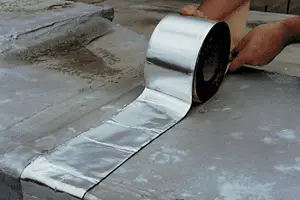A sheet metal roof is a popular choice as it is cheap and versatile. Leaks in sheet metal roofs are quite common and occasionally some leak repairs may be required. Fortunately , they are easy and relatively cheap to repair as long as they are not too badly damaged.
What You Will Need:
- Bitumen Tape – Enough to patch the leaking area
- Blow Torch
- Ladder
- Scissors
Firstly you need to locate the leak, this can be quite tricky. The starting point is to locate the mark on the ceiling board and try to align this with a spot on the roof sheeting bearing in mind that the water may run down the inside of the roof sheeting a small distance before finally dripping onto the ceiling. Common areas for leaks include joins, roof screws, chimneys and skylights, low spots and rusted areas.
Clean up the area to be repaired with a dry rag and some lacquer thinners or mineral turpentine.
Once clean you will need to use a square or strip of bitumen tape to patch the leaking area. Press the section of tape down firmly over the leaking area. Finally, use a blow torch to heat up the reflective surface of the tape. This melts the bitumen underside and makes it stick better to the roof sheeting and to the tape surface so that a strong waterproof bond is formed.
If the damaged area is too large to be patched, you need to consider replacing the single roof sheet. Loosen any screws or nails holding the sheet down and note which of the surrounding sheets overlap it and which it overlaps so that the replacement can be installed the same way. Position the new roof sheet and then screw it into place by driving screws through the ridges (high spots) on the sheeting and not the lower curves as water will be running in these curves when it rains.
Regularly inspect the roof especially after heavy rains or winds. Make sure that the gutters are regularly cleaned and kept unclogged to prevent water from pooling up on the roof. A well installed corrugated roof requires minimal maintenance as long as the drainage is correct and water does not pool up in any areas of the sheeting.




Great.
I have a number of contracts on leaking roofs.
I will share some tricks.